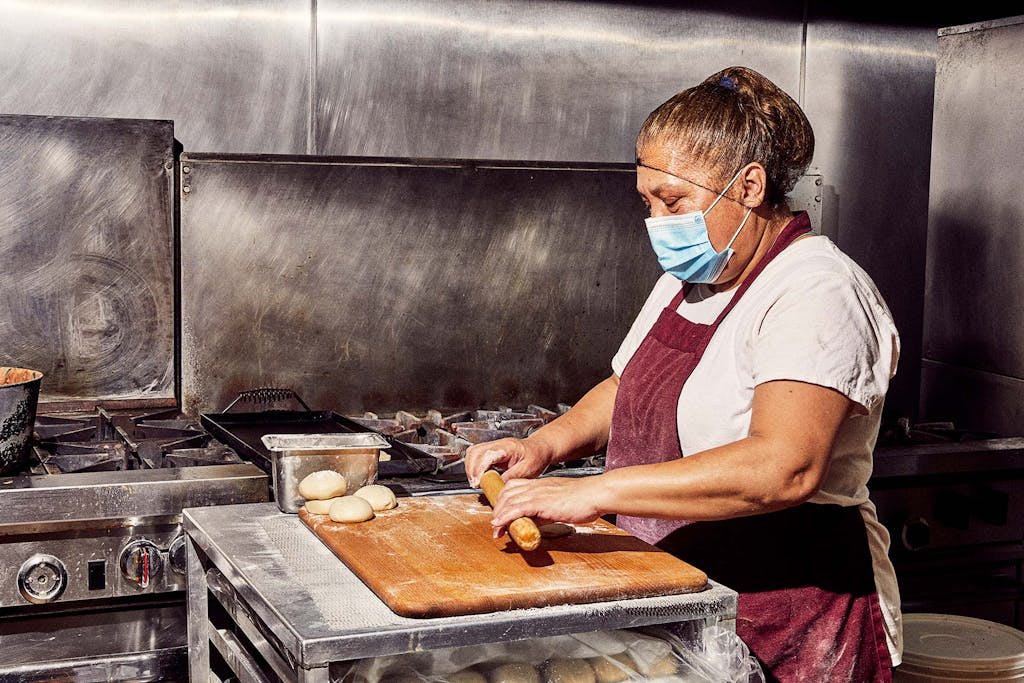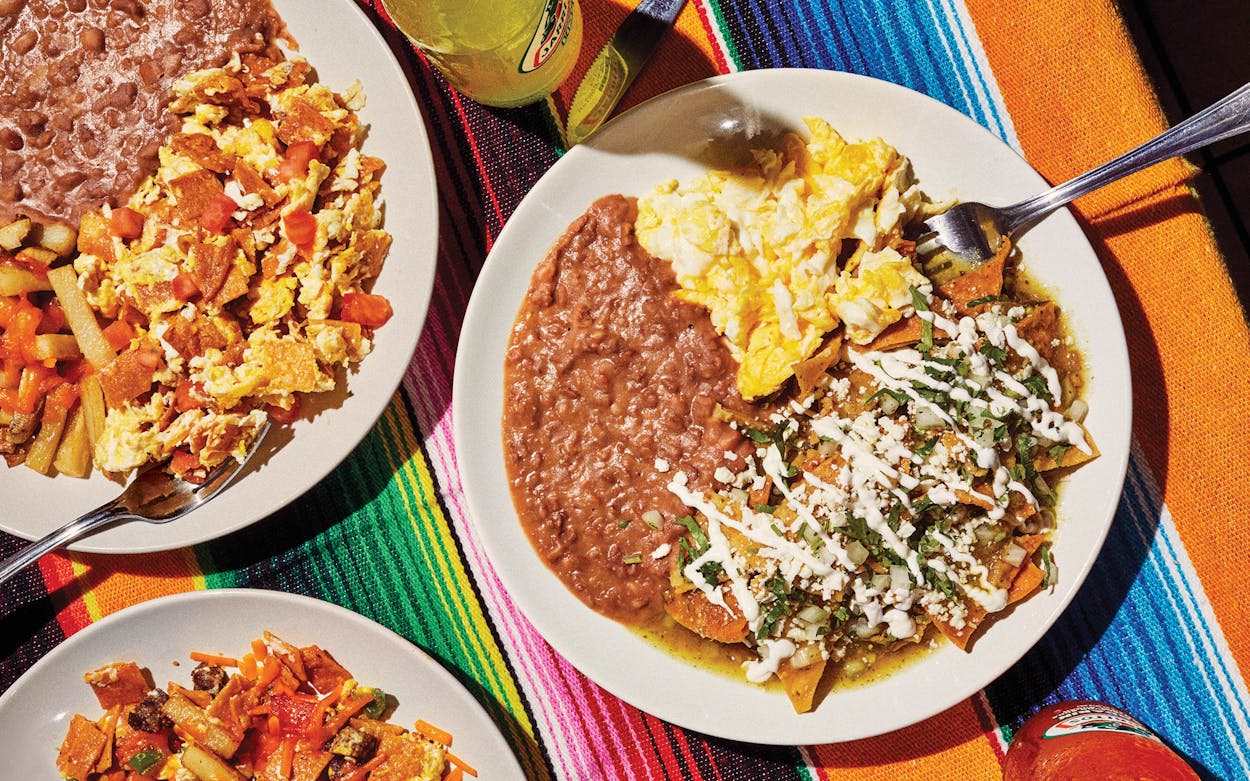Arrive too late at Tía Dora’s Bakery on any morning, and you’ll find yourself standing in line on the sidewalk. Seven days a week, the crowd in Dallas’s Oak Cliff neighborhood patiently waits for the restaurant’s rapturous tamales, breakfast tacos served on spongy house-made flour tortillas, and a vibrantly colored array of pan dulce pastries. Spanish and English are heard sporadically from those gathered outside; mostly, there’s silence. Such is the intense draw of Tía Dora’s—even though the coronavirus has prompted management to shut down indoor dining.
Before pandemic restrictions were imposed, customers would spend their mornings chatting with family and friends in Tía Dora’s cozy booths. And many of them did so over a plate of the panadería’s signature chilaquiles, an unassuming assemblage of salsa-covered crispy corn tortilla triangles topped with a joyful gyroscopic pattern of crema and a heavy shower of queso fresco, with refried beans served on the side. Eggs and other proteins, including shredded chicken, are optional.
Juana Pineda, the general manager and the sister of the bakery’s semiretired owner, Aurora “Tía Dora” Reyes, says chilaquiles are the panadería’s third best-seller, after pastries and tacos. Judging from anecdotal experience, however, I’d say the chilaquiles seem to be the real draw.
Then there are the migas, which can be ordered as a platter or a heaping bowl. As with most of the migas in the state, Tía Dora’s are a lumpy landscape of scrambled eggs studded with pico de gallo, fried or crisped tortilla strips, and cheese. Oddly, in Texas migas and chilaquiles are frequently confused with each other, especially in South Texas, where Mexican menus use the names interchangeably. The mix-up lies in the two dishes’ common denominator, crunchy tortillas.
But there’s a difference in that regard: migas usually feature short strips of fried tortilla, while chilaquiles use what are essentially tortilla chips. There are other distinctions too. The tortillas in migas are mixed with scrambled eggs; chilaquiles’ are drenched in salsa. And though both dishes have roots in Mexico, their histories differ. Chilaquiles’ genesis is largely Indigenous. Migas’ lineage reaches back to Europe.
Yet many restaurateurs and restaurant-goers continue to mistake one for the other, an error that happens more frequently now that chilaquiles are gaining popularity, especially among Anglos. If chilaquiles are on the verge of eclipsing their cousin, it might make sense for Texans to learn to tell them apart.


Chilaquiles were created after the Spanish conquest of Mexico. The name, as the magazine México Desconocido has reported, is derived from the Mesoamerican Nahuatl word chīlaquīlli, which refers to “something that is covered in chili,” as documented in a vocabulary book written by the Spanish priest Alonso de Molina in 1571. However, the first instance of “chilaquiles” that mentions something resembling the dish we know today appears in the 1828 recipe book Arte nuevo de cocina y repostería acomodado al uso mexicano, which refers to it as a dish of fried tortillas, clemole (a tomato-and-chile caldo common in central Mexico), pork or chorizo, and a pinch of sesame seeds. Three years later, a trio of chilaquiles recipes—blancos, rojos/colorados, and tapatíos—were included in the cookbook El cocinero mexicano.
Perhaps the earliest citation in the U.S. appears in El cocinero español, an 1898 collection of Mexican California recipes, which includes instructions for chilaquiles a la mexicana (which features olives), chilaquiles tapatíos a la mexicana (Guadalajara-style chilaquiles, also with olives), and chilaquiles con camarones secos (dried shrimp). The first known print mention of the dish being served in Texas turns up in a 1925 issue of the San Antonio newspaper La Prensa Texas and involves a fond remembrance of a feast of chilaquiles and refried beans.
In the intervening century, chilaquiles’ topping options evolved, with eggs becoming the popular default. Yet the foundation of the dish has always remained those salsa-drenched chips. Today, the simple and satisfying chilaquiles platter is a fixture of Mexican restaurants.
Recently, chilaquiles even inspired an eponymous business. In the summer of 2019 the husband-and-wife team of Orlando and Susana Aguirre opened a food truck called Chilaquil in San Antonio. Last October, Chilaquil moved into the food hall of the historic Pearl District; there, the dish is available as a platter, its chips smeared with salsa roja or enough salsa verde to tinge them green. The chips are then topped with crema and cheese, a shot of chopped cilantro, a fan of avocado slices, and a knot of brilliantly pink pickled onions and buttressed by refried black beans. Though most customers order them topped with fried eggs, it’s not required. “In Texas, most people say chilaquiles need to have an egg on top, but they don’t,” explains Orlando Aguirre. “That’s a choice and one of the differences between chilaquiles and migas.”
It’s tempting to regard migas as yet another Texan adaptation of Mexican cuisine, like chili con carne and puffy tacos. But the story isn’t so clear-cut.
The origins of migas lie in early twentieth-century Mexico. The dish was created out of necessity during the Mexican Revolution and its disastrous consequences, including a brutal famine. Cooking migas (Spanish for “crumbs”) was a way to repurpose stale bread and therefore extend scarce food resources. A descendant of the day-old bread dishes served across Spain, it evolved into variations of a soup thickened with loaves or rolls, something very different from the migas Texans can find at most Mexican restaurants today.
These brothy, Mexican-style migas gained popularity at Migas La Güera, a restaurant in Mexico City’s Tepito neighborhood that was opened in the mid-sixties by José Luis Frausto and his wife, Celia Patiño. In a 2018 El Universal article, Luis Frausto said he first tried a restorative bowl of migas after a soccer match when he was a child. The recipe used at La Güera, which to this day is kept secret by the couple’s children, is reportedly based on his memories of that dish (though some sources give Patiño credit for the recipe). The success of La Güera’s migas—a steaming, ruddy-hued, and herbaceous pork broth thickened with old bread and served with or without pork bones—inspired countless imitators, and today similar migas are served at stands and restaurants across Mexico City and its surrounding municipalities.
A Texas reference to this dish appears as a recipe in a 1922 issue of La Prensa Texas. But this is not, of course, the eggy, broth-free preparation most Texans are familiar with. The first known mention of something resembling that dish shows up as another recipe in a 1951 edition of the Brownsville Herald. The instructions call for powdered eggs, onions, tomatoes, chile powder, and fried strips of tortillas.
It’s tempting to regard this seemingly Americanized dish as yet another Texan adaptation of Mexican cuisine, like chili con carne and puffy tacos. But the story isn’t so clear-cut. When sisters Reyna and Maritza Vazquez were growing up in Veracruz, Mexico, in the eighties and nineties, they often ate a version of migas that was a lot like Tex-Mex migas. “We grew up eating migas from leftovers,” Reyna says. “We always had leftover tortillas. The next day, we would scramble eggs and throw in the tortillas and whatever we had left—some veggies or chorizo or bacon.”
After the sisters immigrated to Austin in 1999, they became interested in opening their own food business. Wanting to offer dishes evocative of their youth, they went in search of the Tex-Mex–style migas they’d grown up with. But the migas they tasted during their research at local restaurants and food trucks had thinner, soggier chips than the ones they remembered.

The sisters tinkered in the kitchen until they settled on a recipe built with their own homemade tortillas. That’s the original migas taco—later joined by a “migas poblanas”—available at Veracruz All Natural, the sisters’ popular fleet of Austin-area trailers, trucks, and brick-and-mortars. That dish is a mix of scrambled eggs, tortilla chips, Monterey Jack, chopped onions, cilantro, and tomatoes and is finished with an avocado wedge and usually served in a fresh corn tortilla. It’s often named one of the best tacos in the city and state.
It’s a breakfast taco that draws lines of customers. Maybe it’s the feel of the crunchy tortilla strips juxtaposed with the soft house-made corn tortilla that brings so many people to the restaurant’s door. But the intense demand might be the dish’s undoing, as the migas taco is, in my experience, somewhat inconsistent. (This is unusual for the otherwise dependable Veracruz All Natural.) Sometimes the filling is salty. Sometimes it’s bland. On occasion, the dish is served cold. Still, Veracruz’s migas tacos have gained national renown via SXSW attendees, who have raved about them on social media.
Migas aren’t the only dish made from leftovers that the Vazquez sisters fondly remember from their childhood. “My mother would make a pot of chilaquiles for the whole family,” Reyna says. And so, in 2011, two years after the sisters started serving tacos, they added chilaquiles to the menu as part of a series of brunch specials. Today, it’s served as a breakfast taco at the downtown location and will soon be added at other locations. Anyone who still confuses migas and chilaquiles can clear up that uncertainty by going to Veracruz All Natural and ordering both of them; there’s really no mistaking one for the other. While eggs dominate the migas, when it comes to the chilaquiles, it’s all about the salsa. As Reyna puts it, “The sauce is the bomb.”
This article originally appeared in the May 2021 issue of Texas Monthly with the headline “Breakfast Cousins, Many Times Removed.” Subscribe today.









